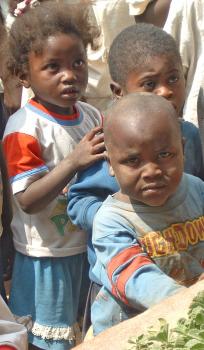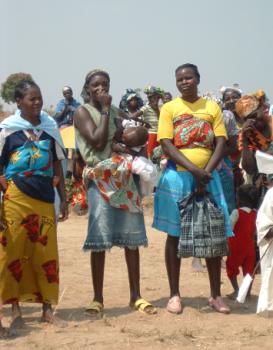A lack of social infrastructure

Huambo lies about 600 kilometres south-east of Luanda, the Angolan capital. The city is the second largest in the country. Huambo province, and the city itself, were most affected by the war; the infrastructure was destroyed and many civilians were killed or forced to leave the area. It was only after the end of the fighting in 2002 that the region was able to start rebuilding its infrastructure, but the progress has been slow. Although subsistence agriculture has traditionally been important for the survival of the local population, the existence of landmines left over from the civil war has largely restricted this activity in recent years.
Angola is undergoing a high rate of urbanisation, and Huambo is no exception. Many of the people who arrive in the city, end up living on the outskirts, in areas where public utilities such as safe drinking water, sewers and refuse collection, let alone education and health facilities, are mostly absent. Most families struggle to eke out a living in their new surroundings.
Children are suffering the consequences of this changing social, political and economic scenario. Thousands of children are chronically malnourished; and many have lost key members of their families during the civil war or due to HIV/AIDS.
Children who have lost parental care would typically be taken in by the extended family, but many families struggle to feed their own children and are unable to take responsibility for additional children. This has led to many child-headed households, where children are forced to beg or work in order to have food to eat. Around half of the children in the country do not receive any form of education and access to medical care is scarce.
Supporting families and children in the area
What we do in Huambo

SOS Children's Villages' work in Huambo includes a variety of programmes to support the local population. Since 2008, the family strengthening programme has provided support to families who are at risk of abandoning their children. Given the high rate of HIV/AIDS in the area, we focus on giving support to families affected by the illness. In collaboration with the community and local authorities, the programme aims to ensure that children have access to essential educational, nutritional and health services. We also help mothers and fathers by giving them advice on parenting and on how to generate income.
Children who have lost parental care can find a loving home in one of the twelve SOS families, where they are affectionately cared for by the SOS mothers. SOS Children’s Villages also runs a kindergarten and a primary school, which is attended by children from the SOS families and from the nearby areas. When we started running the SOS Kindergarten, there were no day-care facilities where children could be looked after while their parents went to work or received training. The kindergarten also provides vital pre-school education which will prepare the children for school. The SOS Hermann Gmeiner School can provide primary education for up to 600 pupils. Through access to education, the children will have a chance of better prospects for the future for themselves as well as their families.